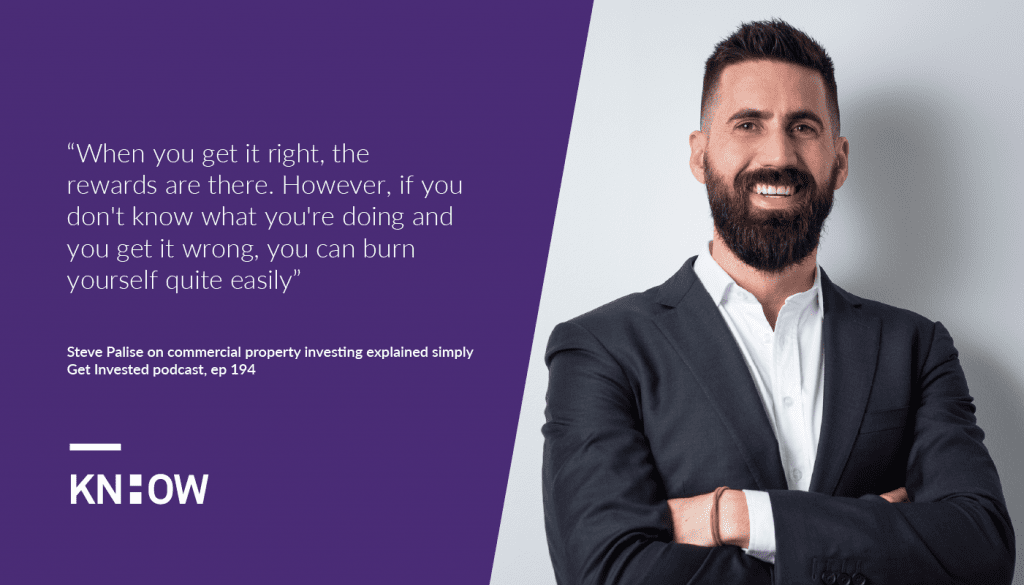Steve Palise says investing in commercial property will bring many benefits as long as you do due diligence and mitigate the main risks.
Some investors steer clear of commercial property because of the perceived risks, but commercial buyers agent Steve Palise says this is often based on common myths.
The founder of Palise Property told KnowHow founder Bushy Martin on the Get Invested podcast that he was initially hesitant about commercial property before he broadened his knowledge.
“I just thought it was too risky and it wasn’t understood well enough. So I was a buyers agent for about five or six years and I’d purchased over 500 residential properties, and now and then, I just had one client who said ‘can you buy me a commercial property?’ And I tried to actually talk him out of it at the time. But then once I actually started looking at it and just doing it with an analytical mind, you actually can mitigate most risks,” Steve said.
“There are a lot more moving parts with commercial, so you do have to be mindful of that. But when you get it right, the rewards are there. However, if you don’t know what you’re doing and you get it wrong, you can obviously burn yourself quite easily because if you buy a warehouse and it sits there for two or three years, that’s going to sting. Whereas with residential, as long as you take some of the fundamentals and you buy a good quality house in a good quality suburb, you’re always going to have a tenant. So you’re going to have that income coming in. So you’ve just got to be very mindful of mitigating the risk of vacancy.”
The first myth that can deter investors is the idea that commercial property doesn’t have capital growth.
“So the main reason most investors invest in commercial is the cash flow. There is a misconception they don’t have capital growth, but that’s completely false. They’ve actually almost got exactly the same capital growth as residential property, it just happens in different cycles,” Steve said.
“There are some types of commercial properties that don’t grow the same as others, of course. So like office space, if you’re buying a 20-storey skyscraper office suite that doesn’t have a land component, that’s not going to have the same capital growth as a warehouse or a freestanding building, much the same as how a high density residential apartment doesn’t have the same capital growth as a house. So you’re not comparing apples and apples. They’ll have different growth rates depending on the asset classes.”
While Steve said the risk of extended vacancy periods isn’t a myth, it is something that can be avoided.
“You can buy commercial properties that don’t have a high vacancy. It’s similar to not going out and buying a residential property in a mining town that’s high risk. So stick to the fundamentals,” he said.
“They all have different vacancy periods, so you really have to understand the asset that you’re buying and this comes down to due diligence. You have to basically do it yourself. So you go through and find all the comparables in the area, when they went vacant, how long were they vacant for and things like that.
“So once you do the work, you can basically expel that myth and actually buy a lower risk vacancy period property. And if you’re buying a versatile property, you can also mitigate the risk.”
In order to gain confidence on a potential property and conduct due diligence, Steve said investors should first research the area and complex.
“Much the same as residential, look at the area that you’re buying in. So is there population growth there? Is there infrastructure spending? What type of competition is in the area for your business? Things like that. So choosing the location is obviously the first one,” he said.
“Then you question if the industrial complex that you’re buying in is a good one. Is it clean and tidy? Does it have good access? Are you buying a service-based industrial? Are you buying a distribution-based one? That’ll change the type of size and location you can get as well.”
Once you’ve locked in a potential property and identified the vacancy periods, investors can then conduct a thorough analysis of the property.
“Once you’ve got a good, low risk asset, then you start doing the hard core due diligence and that’s checking things like the square metre rates for sale, looking at the actual warehouse itself like is the mezzanine approved, and basically looking at the versatility. Is the area more prone to having 30% office space or 50% office space? What types of tenants you can get in? What different arrangements can you have? That’s going to change on your location and the type of asset,” Steve said.
Like residential, knowing your tenants is key in commercial property.
“If you’re buying a (commercial property) with a tenant, which I normally recommend if you’re starting out so that way you get the cash flow from day one, you need to investigate the tenant,” Steve said. “So checking things like how long have they been there? Have they always paid rent? Are they established? Check their rental ledgers to make sure they’re basically paying rent regularly and check who their competition is in the area,” he said.
“Then part of that will be doing things like a lease review, looking through the contracts, the business, the financials, the rental ledgers. It’s just a really kind of strict routine of checking everything to do with that business.”
Listen to the full interview here.
Want to Know How you can build wealth with the help of leading, qualified experts? Talk to the team at KnowHow, now.




